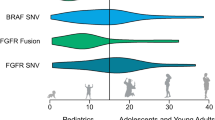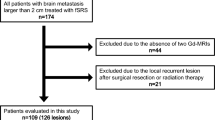Abstract
Purpose
Progressive pediatric optic pathway gliomas (OPGs) are treated by diverse systemic antitumor modalities. Refined insights on the course of intra-tumoral components are limited.
Methods
We performed an exploratory study on the longitudinal volumetric course of different (intra-)tumor components by manual segmentation of MRI at the start and after 3, 6 and 12 months of bevacizumab (BVZ) treatment.
Results
Thirty-one patients were treated with BVZ (median 12 months, range: 2–39 months). During treatment the total tumor volume decreased with median 19.9% (range: − 62.3 to + 29.7%; n = 30) within the first 3 months, decreased 19.0% (range: − 68.8 to + 96.1%; n = 28) between start and 6 months and 27.2% (range: −73.4 to + 36.0%; n = 21) between start and 12 months. Intra-tumoral cysts were present in 12 OPGs, all showed a decrease of volume during treatment. The relative contrast enhanced volume of NF1 associated OPG (n = 11) showed an significant reduction compared to OPG with a KIAA1549-BRAF fusion (p < 0.01). Three OPGs progressed during treatment, but were not preceded by an increase of relative contrast enhancement.
Conclusion
Treatment with BVZ of progressive pediatric OPGs leads to a decrease of both total tumor volume and cystic volume for the majority of OPGs with emphasis on the first three months. NF1 and KIAA1549-BRAF fusion related OPGs showed a different (early) treatment effect regarding the tumor enhancing component on MRI, which did not correlate with tumor volume changes. Future research is necessary to further evaluate these findings and its relevance to clinical outcome parameters.



Similar content being viewed by others
Data availability
The datasets generated during and/or analysed during the current study are available from the corresponding author on reasonable request.
Abbreviations
- BVZ:
-
Bevacizumab
- IRI:
-
Irinotecan
- KIAA1549-BRAF:
-
Fusion of the human gene that encodes the KIAA1549 protein and the B-raf: (proto-)oncogene
- MDC:
-
Modified Dodge Classification
- NF1:
-
Neurofibromatosis type 1
- nNF1:
-
No neurofibromatosis type 1
- OPG:
-
Optic pathway glioma
- PMA:
-
Pilomyxoid astrocytoma
- PP:
-
Percent point
- SAT:
-
Systemic anticancer therapy
- Segmentation:
-
Manual volumetric segmentation
- TTV:
-
Total tumor volume
- TDM:
-
Tumor diameter measurements
- VBL:
-
Vinblastin
References
Falzon K, Drimtzias E, Picton S, Simmons I (2018) Visual outcomes after chemotherapy for optic pathway glioma in children with and without neurofibromatosis type 1: results of the International Society of Paediatric Oncology (SIOP) low-grade glioma 2004 trial UK cohort. Br J Ophthalmol 102(10):1367–1371. https://doi.org/10.1136/bjophthalmol-2017-311305
Gil Margolis M, Yackobovitz-Gavan M, Toledano H, Tenenbaum A, Cohen R, Phillip M, Shalitin S (2023) Optic pathway glioma and endocrine disorders in patients with and without NF1. Pediatr Res 93:233–241. https://doi.org/10.1038/s41390-022-02098-5
Santoro C, Perrotta S, Picariello S, Scilipoti M, Cirillo M, Quaglietta L, Cinalli G, Cioffi D, Di Iorgi N, Maghnie M, Gallizia A, Parpagnoli M, Messa F, De Sanctis L, Vannelli S, Marzuillo P, Miraglia Del Giudice E, Grandone A (2020) Pretreatment endocrine disorders due to optic pathway gliomas in pediatric neurofibromatosis type 1: multicenter study. J Clin Endocrinol Metab 105:e2214–e2221. https://doi.org/10.1210/clinem/dgaa138
Opocher E, Kremer LC, Da Dalt L, van de Wetering MD, Viscardi E, Caron HN, Perilongo G (2006) Prognostic factors for progression of childhood optic pathway glioma: a systematic review. Eur J Cancer 42:1807–1816. https://doi.org/10.1016/j.ejca.2006.02.022
Hawkins C, Walker E, Mohamed N, Zhang C, Jacob K, Shirinian M, Alon N, Kahn D, Fried I, Scheinemann K, Tsangaris E, Dirks P, Tressler R, Bouffet E, Jabado N, Tabori U (2011) BRAF-KIAA1549 fusion predicts better clinical outcome in pediatric low-grade astrocytoma. Clin Cancer Res 17:4790–4798. https://doi.org/10.1158/1078-0432.Ccr-11-0034
Fangusaro J, Witt O, Hernáiz Driever P, Bag AK, de Blank P, Kadom N, Kilburn L, Lober RM, Robison NJ, Fisher MJ, Packer RJ, Young Poussaint T, Papusha L, Avula S, Brandes AA, Bouffet E, Bowers D, Artemov A, Chintagumpala M, Zurakowski D, van den Bent M, Bison B, Yeom KW, Taal W, Warren KE (2020) Response assessment in paediatric low-grade glioma: recommendations from the response assessment in pediatric neuro-oncology (RAPNO) working group. Lancet Oncol 21:e305–e316. https://doi.org/10.1016/s1470-2045(20)30064-4
Fisher MJ, Avery RA, Allen JC, Ardern-Holmes SL, Bilaniuk LT, Ferner RE, Gutmann DH, Listernick R, Martin S, Ullrich NJ, Liu GT (2013) Functional outcome measures for NF1-associated optic pathway glioma clinical trials. Neurology 81:S15–S24. https://doi.org/10.1212/01.wnl.0000435745.95155.b8
Shofty B, Ben-Sira L, Freedman S, Yalon M, Dvir R, Weintraub M, Toledano H, Constantini S, Kesler A (2011) Visual outcome following chemotherapy for progressive optic pathway gliomas. Pediatr Blood Cancer 57:481–485. https://doi.org/10.1002/pbc.22967
Weizman L, Sira LB, Joskowicz L, Rubin DL, Yeom KW, Constantini S, Shofty B, Bashat DB (2014) Semiautomatic segmentation and follow-up of multicomponent low-grade tumors in longitudinal brain MRI studies. Med Phys 41:052303
Shofty B, Mauda-Havakuk M, Weizman L, Constantini S, Ben-Bashat D, Dvir R, Pratt LT, Joskowicz L, Kesler A, Yalon M, Ravid L, Ben-Sira L (2015) The effect of chemotherapy on optic pathway gliomas and their sub-components: a volumetric MR analysis study. Pediatr Blood Cancer 62:1353–1359. https://doi.org/10.1002/pbc.25480
Azizi AA, Schouten-van Meeteren AYN (2018) Current and emerging treatment strategies for children with progressive chiasmatic-hypothalamic glioma diagnosed as infants: a web-based survey. J Neuro-Oncol 136:127–134. https://doi.org/10.1007/s11060-017-2630-6
Green K, Panagopoulou P, D’Arco F, O’Hare P, Bowman R, Walters B, Dahl C, Jorgensen M, Patel P, Slater O, Ahmed R, Bailey S, Carceller F, Collins R, Corley E, English M, Howells L, Kamal A, Kilday JP, Lowis S, Lumb B, Pace E, Picton S, Pizer B, Shafiq A, Uzunova L, Wayman H, Wilson S, Hargrave D, Opocher E (2022) A nationwide evaluation of bevacizumab-based treatments in paediatric low-grade glioma in the UK: safety. Efficacy, visual morbidity and outcomes. Neuro Oncol. https://doi.org/10.1093/neuonc/noac223
Bennebroek CAM, van Zwol J, Porro GL, Oostenbrink R, Dittrich ATM, Groot ALW, Pott JW, Janssen EJM, Bauer NJ, van Genderen MM, Saeed P, Lequin MH, de Graaf P, Schouten-van Meeteren AYN (2022) Impact of bevacizumab on visual function, tumor size, and toxicity in pediatric progressive optic pathway glioma: a retrospective nationwide multicentre study. Cancers 14:6087. https://doi.org/10.3390/cancers14246087
Sikkema AH, de Bont ES, Molema G, Dimberg A, Zwiers PJ, Diks SH, Hoving EW, Kamps WA, Peppelenbosch MP, den Dunnen WF (2011) Vascular endothelial growth factor receptor 2 (VEGFR-2) signalling activity in paediatric pilocytic astrocytoma is restricted to tumour endothelial cells. Neuropathol Appl Neurobiol 37:538–548. https://doi.org/10.1111/j.1365-2990.2011.01160.x
Taylor T, Jaspan T, Milano G, Gregson R, Parker T, Ritzmann T, Benson C, Walker D, Group PS (2008) Radiological classification of optic pathway gliomas: experience of a modified functional classification system. Br J Radiol 81:761–766. https://doi.org/10.1259/bjr/65246351
Bø HK, Solheim O, Jakola AS, Kvistad KA, Reinertsen I, Berntsen EM (2017) Intra-rater variability in low-grade glioma segmentation. J Neurooncol 131:393–402. https://doi.org/10.1007/s11060-016-2312-9
Rozenfeld MN, Podberesky DJ (2018) Gadolinium-based contrast agents in children. Pediatr Radiol 48:1188–1196. https://doi.org/10.1007/s00247-018-4165-1
Kilian A, Aigner A, Simon M, Salchow DJ, Potratz C, Thomale UW, Hernaiz Driever P, Tietze A (2022) Tumor load rather than contrast enhancement is associated with the visual function of children and adolescents with optic pathway glioma—a retrospective magnetic resonance imaging study. J Neurooncol 156:589–597. https://doi.org/10.1007/s11060-021-03941-1
Jain RK, di Tomaso E, Duda DG, Loeffler JS, Sorensen AG, Batchelor TT (2007) Angiogenesis in brain tumours. Nat Rev Neurosci 8:610–622. https://doi.org/10.1038/nrn2175
Menze BH, Jakab A, Bauer S, Kalpathy-Cramer J, Farahani K, Kirby J, Burren Y, Porz N, Slotboom J, Wiest R, Lanczi L, Gerstner E, Weber MA, Arbel T, Avants BB, Ayache N, Buendia P, Collins DL, Cordier N, Corso JJ, Criminisi A, Das T, Delingette H, Demiralp Ç, Durst CR, Dojat M, Doyle S, Festa J, Forbes F, Geremia E, Glocker B, Golland P, Guo X, Hamamci A, Iftekharuddin KM, Jena R, John NM, Konukoglu E, Lashkari D, Mariz JA, Meier R, Pereira S, Precup D, Price SJ, Raviv TR, Reza SM, Ryan M, Sarikaya D, Schwartz L, Shin HC, Shotton J, Silva CA, Sousa N, Subbanna NK, Szekely G, Taylor TJ, Thomas OM, Tustison NJ, Unal G, Vasseur F, Wintermark M, Ye DH, Zhao L, Zhao B, Zikic D, Prastawa M, Reyes M, Van Leemput K (2015) The multimodal brain tumor image segmentation benchmark (BRATS). IEEE Trans Med Imaging 34:1993–2024. https://doi.org/10.1109/tmi.2014.2377694
Funding
This study was funded by the ODAS foundation: grant number: 2019-01.
Author information
Authors and Affiliations
Contributions
CAB: Conceptualisation, funding acquisition, methodology, project administration, resources, supervision, validation, writing, original draft preparation. CRS: Data curation, formal analysis, investigation, methodology, project administration, visualisation, writing—original draft preparation. MCMS: Resources, writing, original draft preparation. PS: Funding, writing—review and editing. GLP: Resources, writing—review and editing. JWRP: Resources, writing—review and editing. ATD: Resources, writing—review and editing. RO: Resources, writing—review and editing. AYSM: Funding acquisition, methodology, resources, writing—review and editing. MCJ: Methodology, investigation, normal analysis, writing—review and editing. PG: Conceptualization, methodology, investigation, resources, writing—review and editing, supervision, funding acquisition.
Corresponding author
Ethics declarations
Competing interests
Author R. Oostenbrink provides advisory consultations for Alexion, with incidental honoraria and is a full member of Genturis ERN.
Ethical approval
This is a retrospective study. The Research Ethics Committee of the Amsterdam UMC, Erasmus MC, Radboud UMC and UMC Groningen have confirmed that no ethical approval is required. Approval according to the principles of the Declaration of Helsinki was granted by the Ethics Committee of University of the UMC Utrecht, Princess Máxima Center.
Informed consent
Written informed consent for the use of patient data was obtained from parents, legal guardian(s) or children depending on the age of the patients.
Additional information
Publisher's Note
Springer Nature remains neutral with regard to jurisdictional claims in published maps and institutional affiliations.
Supplementary Information
Below is the link to the electronic supplementary material.
Rights and permissions
Springer Nature or its licensor (e.g. a society or other partner) holds exclusive rights to this article under a publishing agreement with the author(s) or other rightsholder(s); author self-archiving of the accepted manuscript version of this article is solely governed by the terms of such publishing agreement and applicable law.
About this article
Cite this article
Bennebroek, C.A., Schouten, C.R., Montauban-van Swijndregt, M.C. et al. Treatment evaluation by volumetric segmentation in pediatric optic pathway glioma: evaluation of the effect of bevacizumab on intra-tumor components. J Neurooncol 166, 79–87 (2024). https://doi.org/10.1007/s11060-023-04516-y
Received:
Accepted:
Published:
Issue Date:
DOI: https://doi.org/10.1007/s11060-023-04516-y




